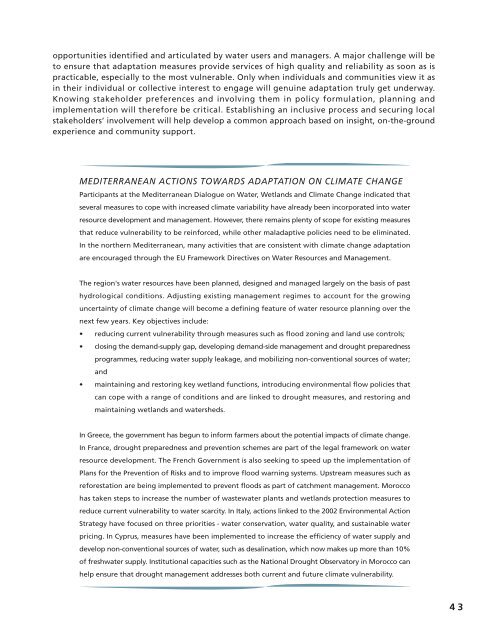Adaptation of water resources management to climate change
Adaptation of water resources management to climate change
Adaptation of water resources management to climate change
Create successful ePaper yourself
Turn your PDF publications into a flip-book with our unique Google optimized e-Paper software.
opportunities identified and articulated by <strong>water</strong> users and managers. A major challenge will be<strong>to</strong> ensure that adaptation measures provide services <strong>of</strong> high quality and reliability as soon as ispracticable, especially <strong>to</strong> the most vulnerable. Only when individuals and communities view it asin their individual or collective interest <strong>to</strong> engage will genuine adaptation truly get underway.Knowing stakeholder preferences and involving them in policy formulation, planning andimplementation will therefore be critical. Establishing an inclusive process and securing localstakeholders’ involvement will help develop a common approach based on insight, on-the-groundexperience and community support.MEDITERRANEAN ACTIONS TOWARDS ADAPTATION ON CLIMATE CHANGEParticipants at the Mediterranean Dialogue on Water, Wetlands and Climate Change indicated thatseveral measures <strong>to</strong> cope with increased <strong>climate</strong> variability have already been incorporated in<strong>to</strong> <strong>water</strong>resource development and <strong>management</strong>. However, there remains plenty <strong>of</strong> scope for existing measuresthat reduce vulnerability <strong>to</strong> be reinforced, while other maladaptive policies need <strong>to</strong> be eliminated.In the northern Mediterranean, many activities that are consistent with <strong>climate</strong> <strong>change</strong> adaptationare encouraged through the EU Framework Directives on Water Resources and Management.The region's <strong>water</strong> <strong>resources</strong> have been planned, designed and managed largely on the basis <strong>of</strong> pasthydrological conditions. Adjusting existing <strong>management</strong> regimes <strong>to</strong> account for the growinguncertainty <strong>of</strong> <strong>climate</strong> <strong>change</strong> will become a defining feature <strong>of</strong> <strong>water</strong> resource planning over thenext few years. Key objectives include:• reducing current vulnerability through measures such as flood zoning and land use controls;• closing the demand-supply gap, developing demand-side <strong>management</strong> and drought preparednessprogrammes, reducing <strong>water</strong> supply leakage, and mobilizing non-conventional sources <strong>of</strong> <strong>water</strong>;and• maintaining and res<strong>to</strong>ring key wetland functions, introducing environmental flow policies thatcan cope with a range <strong>of</strong> conditions and are linked <strong>to</strong> drought measures, and res<strong>to</strong>ring andmaintaining wetlands and <strong>water</strong>sheds.In Greece, the government has begun <strong>to</strong> inform farmers about the potential impacts <strong>of</strong> <strong>climate</strong> <strong>change</strong>.In France, drought preparedness and prevention schemes are part <strong>of</strong> the legal framework on <strong>water</strong>resource development. The French Government is also seeking <strong>to</strong> speed up the implementation <strong>of</strong>Plans for the Prevention <strong>of</strong> Risks and <strong>to</strong> improve flood warning systems. Upstream measures such asreforestation are being implemented <strong>to</strong> prevent floods as part <strong>of</strong> catchment <strong>management</strong>. Moroccohas taken steps <strong>to</strong> increase the number <strong>of</strong> waste<strong>water</strong> plants and wetlands protection measures <strong>to</strong>reduce current vulnerability <strong>to</strong> <strong>water</strong> scarcity. In Italy, actions linked <strong>to</strong> the 2002 Environmental ActionStrategy have focused on three priorities - <strong>water</strong> conservation, <strong>water</strong> quality, and sustainable <strong>water</strong>pricing. In Cyprus, measures have been implemented <strong>to</strong> increase the efficiency <strong>of</strong> <strong>water</strong> supply anddevelop non-conventional sources <strong>of</strong> <strong>water</strong>, such as desalination, which now makes up more than 10%<strong>of</strong> fresh<strong>water</strong> supply. Institutional capacities such as the National Drought Observa<strong>to</strong>ry in Morocco canhelp ensure that drought <strong>management</strong> addresses both current and future <strong>climate</strong> vulnerability.43











![View full document [PDF 988.55 KB] - PreventionWeb](https://img.yumpu.com/47733942/1/184x260/view-full-document-pdf-98855-kb-preventionweb.jpg?quality=85)
![View full document (in French) [PDF 4.96 MB] - PreventionWeb](https://img.yumpu.com/47223870/1/184x260/view-full-document-in-french-pdf-496-mb-preventionweb.jpg?quality=85)


![View full document [PDF 25.02 MB] - PreventionWeb](https://img.yumpu.com/44204570/1/190x234/view-full-document-pdf-2502-mb-preventionweb.jpg?quality=85)
